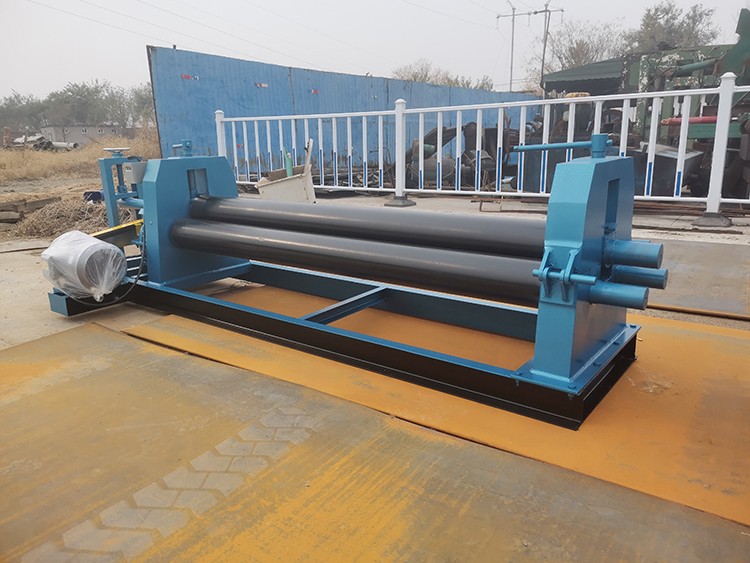

We are a professional manufacturer of plate rolling machines with over 10 years of industry experience. Today, we would like to introduce the working principle of plate rolling machine to you:

In the metal processing industry, the plate rolling machine as an important molding equipment, through the precision mechanical structure and intelligent control system of the synergistic operation, can be processed into various types of sheet metal complex geometric form of components, its working principle fully embodies the depth of integration of material mechanics and mechanical engineering technology.
1, The mechanics of the core structure
The core working unit of the plate rolling machine consists of a high-precision roller system, which realizes controlled deformation of the metal sheet through a specific spatial layout. The main drive mechanism contains vertically adjustable upper roller and horizontally rotating lower roller group, forming a stable triangular force structure. The upper rollers are driven by a hydraulic servo system for high precision vertical displacement control, while the lower rollers are driven by a synchronized gear system to ensure precise synchronization of the rotational movement. This three-point stress pattern can keep the stress distribution uniform during the bending process.
According to different molding requirements, the roller system has various structural designs.
(1)Symmetrical three-roller structure is suitable for efficient processing of cylindrical surfaces;
(2)Asymmetric structure can realize precise forming of conical surface by adjusting the roller pitch;
(3)The four-roller model adds auxiliary positioning rollers, which can effectively solve the problem of incomplete molding at the end of the plate and improve the processing quality.
2, Progressive molding process method
Roll plate processing is based on the progressive principle of plastic deformation of materials. When the plate enters the working area of the roll axis, the upper roller gradually applies pressure by means of graded loading to produce local yield deformation of the plate. With the continuous rotation of the roller shaft, the plate is rolled several times, and the amount of downward pressure of the upper roller is precisely controlled at each pass to gradually increase the bending curvature. Adopting the processing strategy of “small deformation, multiple passes” not only ensures the uniform release of internal stresses, but also avoids cracks or distortions in the plate due to excessive deformation in a single pass.
During processing, the operator sets the process parameters through the CNC system, precisely controls the roller movement trajectory and loading rate, and gradually completes the curved surface molding of the plate according to the predefined process requirements.
3, The technical advantages of intelligent control
The modern rolling machine is equipped with an advanced digital control system, which builds up a closed-loop feedback adjustment system. The system collects real-time roll pressure load, plate displacement, curvature change and other parameters through multi-dimensional sensors, utilizes the built-in algorithm model to predict the rebound of the material, and automatically adjusts the processing parameters. For different material characteristics, the system can intelligently match the corresponding process plan: automatically reduce the feed rate to ensure molding accuracy when processing high-strength alloy steel; high-frequency micro-amplitude loading mode to prevent plate instability and deformation when dealing with ultra-thin plates.
The CNC system is equipped with a three-dimensional visualization interface, which supports rapid import of target models and intelligent planning of machining paths. Through the simulation function, the molding effect can be predicted before machining, which significantly improves the machining accuracy and production efficiency, and realizes the high-precision machining of complex surfaces.
4, Diversified molding industrial applications
With good process adaptability, the plate rolling machine can realize diversified molding processing. By adjusting the roll inclination and loading parameters, it can not only process conventional geometric shapes such as cylindrical and conical, but also complete the processing of complex curved surfaces such as wavy and prismatic surfaces with special molds. Rolling machines are widely used in.
In the manufacture of nuclear power equipment, the coiler can process ultra-thick special steel plate into key components of the reactor pressure vessel; in the aerospace field, it can complete the precision molding of high-performance titanium alloy fuel storage tank shell. Its ability to process across different sizes and materials has established an important position in modern manufacturing.
The working process of the plate rolling machine is the process of interaction between the mechanical force field action and material properties. Through the innovative application of the principle of mechanics, realized the transformation of metal plate from flat plate to complex components, showing the technical progress and engineering value in the field of machinery manufacturing.
If you are interested in plate rolling machine, please contact us.
 Address:Room 1202, Detaitang Building, No. 118 Huaguang Road, Zhangdian District, Zibo, Shandong
Address:Room 1202, Detaitang Building, No. 118 Huaguang Road, Zhangdian District, Zibo, Shandong WhatsApp:+8615653328535
WhatsApp:+8615653328535 Wechat: +8615965331535
Wechat: +8615965331535  E-mail:zs@sdsmachinery.com
E-mail:zs@sdsmachinery.com